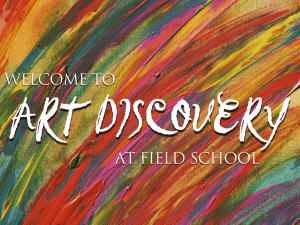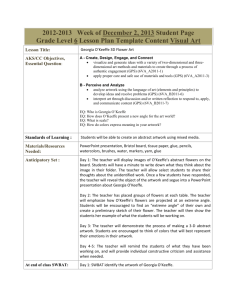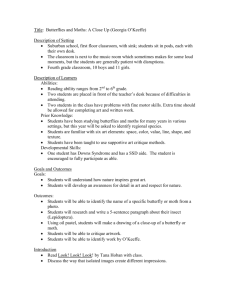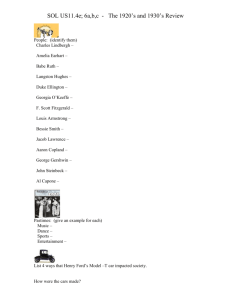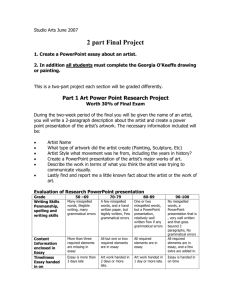Georgia O*Keefe
advertisement
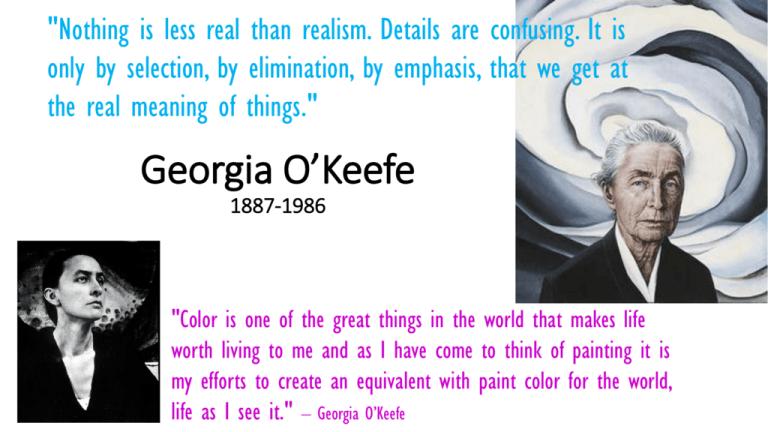
"Nothing is less real than realism. Details are confusing. It is only by selection, by elimination, by emphasis, that we get at the real meaning of things." Georgia O’Keefe 1887-1986 "Color is one of the great things in the world that makes life worth living to me and as I have come to think of painting it is my efforts to create an equivalent with paint color for the world, life as I see it." – Georgia O’Keefe Georgia O’Keefe • produced more than 2000 works over the course of her career. • she is the most important and influential American painters • for nearly a century, O’Keeffe’s representations of the beauty of the American landscape were a brave counterpoint to the chaotic images embraced by the art world. • her cityscapes and still-life filled the canvas with wild energy that gained her a following among the critics as well as the public. • she has had many imitators, but no one has been able to paint with such intimacy and stark precision. Georgia O’Keefe married a photographer, Alfred Steiglitz. He took over 300 intimate pictures of her, including some nudes, and they were included in a gallery show. A short while later, she had her own exhibit, with paintings like those below, and her reputation as being overly sexual began. She was horrified and stunned by this response–this is simply how she saw nature. With colors, and openings, and softness. Her reaction was to abandon representational art and depict the obvious. A pear is a pear. And her beloved flowers were merely that: flowers. But critics still assigned sexuality to them. So she gave up on the critics and painted what she felt. At first, it was flowers. She chose to enlarge flowers to put them at scale with the explosion of large buildings in New York during the 1920s. She presumed that people would be startled by such large flowers and be compelled to look. She was right. O’Keeffe had an intense emotional connection with nature and a compulsive need to create its equivalent in art.* She loved this mountain intensely, viewed from her property, and wrote to a friend that “G-d told me if I painted the mountain enough, He would give it to me.” • GEORGIA O'KEEFFE KEY IDEASO'Keeffe incorporated the techniques of other artists and was especially influenced by Paul Strand's use of cropping in his photographs; she was one of the first artists to adapt the method to painting by rendering close-ups of uniquely American objects that were highly detailed yet abstract. • O'Keeffe did not follow any specific artistic movement, but like Arthur Dove she experimented with abstracting motifs from nature. She worked in series, synthesizing abstraction and realism to produce works that emphasized the primary forms of nature. While some of these works are highly detailed, in others, she stripped away what she considered the inessential to focus on shape and color. • Through intense observation of nature, experimentation with scale, and nuanced use of line and color, O'Keeffe's art remained grounded in representation even while pushing at its limits. From the 1940s through the 1960s in particular, O'Keeffe's art was outside the mainstream as she was one of the few artists to adhere to representation in a period when others were exploring non-representation or had abandoned painting altogether. • Georgia O'Keeffe played a pivotal role in the development of American modernism and its relationship to European avante garde movements of the early twentieth century. Producing a substantial body of work over seven decades, she sought to capture the emotion and power of objects through abstracting the natural world. Alfred Stieglitz identified her as the first female American modernist, whose paintings of flowers, barren landscapes, and close-up still lifes have become a part of the mythology and iconography of the American artistic landscape. Georgia O’Keefe Music pink and blue II (1918) Oil on Canvas 59. Georgia O’Keefe Black Mesa Landscape, New Mexico 1930 Oil on canvas A Sense of Place documents O'Keeffe's extraordinary ability to capture the contours, colors, and textures of the land that fascinated her while remaining true to her life-long interest in and commitment to exploring issues of abstraction. 59. Georgia O'Keeffe Ram's Head, Blue Morning Glory 1938. Oil on canvas. • Teaching in South Carolina was Arthur Dow, a specialist in Oriental Art. Dow’s interest in non-European art helped O’Keeffe move away from the forms she had found so stifling in her previous studies. She said of him, “It was Arthur Dow who affected my start, who helped me to find something of my own.” Soon after O’Keeffe’s return to Texas, she made a handful of charcoal drawings, which she sent to a friend in New York. The friend, Anna Pollitzer, showed them to Alfred Stieglitz, a photographer and gallery owner. He was enthused with the vibrant energy of the work, and asked to show them. So, without her knowledge, Georgia O’Keeffe had her first exhibition in 1916 at Steiglitz’s “291 Gallery.” • Within two years, Steiglitz had convinced O’Keeffe to move to New York and devote all of her time to painting. His regular presentations of her work had begun to cause a buzz, and create for a her a small following. Six years later the two were married, beginning one of the most fruitful and well-known collaborations of the modernist era. For the next twenty years the two would live and work together, Steiglitz creating an incredible body of portraits of O’Keeffe, while O’Keeffe showed new drawings and paintings nearly every year at the gallery. Living in Lake George, New York, and in New York City, O’Keeffe painted some of her most famous work. During the 1920s, her large canvasses of lush overpowering flowers filled the still lifes with dynamic energy and erotic tension, while her cityscapes were testaments to subtle beauty within the most industrial circumstances. • In 1929 O’Keeffe took a vacation with her friend Beck Strand to Taos, New Mexico. The trip would forever alter the course of her life. In love with the open skies and sun-drenched landscape, O’Keeffe returned every summer to travel and to paint. When Steiglitz in 1946 died, O’Keeffe took up permanent residence there. More than almost any of her other works, these early New Mexico landscapes and still lifes have come to represent her unique gifts. The rich texture of the clouds and sky were similar to her earlier, more sensuous representations of flowers. But beneath these clouds one found the bleached bones of animals long gone.

